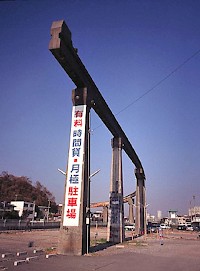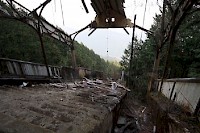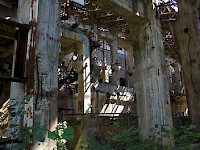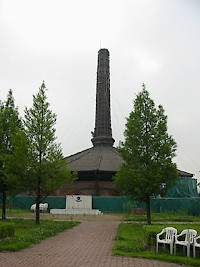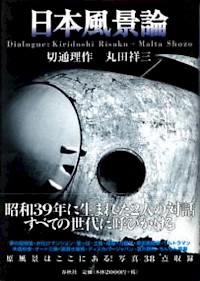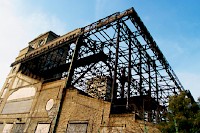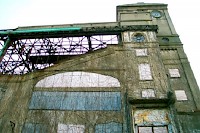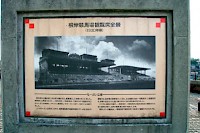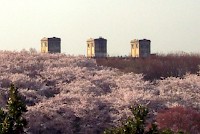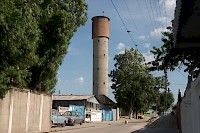In the following I mean to put into discussion a constant fascination which manifests or ruins of various technological eras in alternative cultural practices. The progressive and evolutive side of history is in these practices put into question by the means of its own vestiges, which instead of pointing to the past, become de-contextualised pieces in an imaginary cabinet of curiosity, which the present needs to re-situate, in order to understand itself. All these works have in common an exoticisation and museification of the technological past, in which interaction means re-classification, re-designation up to complete fictionalisation. Past technologies become a science fiction from an imaginary and remote past about a deviant future. Paradoxically all these practices and works are means of investigating the present, of getting to its roots with political substrata.
In an article on the idea of ruins in the European culture, Rosa Olivares1 describes the ruins in the contemporary society as a product between various different cosmetised and artificially aesthetised products. This well packed ruins make it easier for the consumer to assimilate the tragedy and catastrophy, of which ruins are the concrete consequence. It is in the European tradition, that ruins are for the elite an aesthetical category. Rosa Olivares is questioning the circumstances in which in the European history, particullarly since the Renaissance, ruins became a positively connotated symbol, a symbol for noble values, transformation, progress and aesthetical intensity. As opposed to the Romantic ruin, the contemporary ruin, is exposed to a very rapid transformation from the moment of destrution to its transformation into an artistic product. While in Romantism information on the distant social or political aspects of a catastrophy were missing, the contemporary approach of the ruins of the present, ignors the human aspects of this catastrophy, which can be consumed and transformed into a artistic product only in an artificially cleaned shape. Not like the ruins of the past, which gain a mythical character through the force of a collective memory, we share with the ruins of our society the same temporal sequence. Therefor these ruins of the present cannot have a romantic charge and cannot be a symbol of reconstruction, but can only be a symbol of destruction. For Rosa Olivares this present preoccupation of the contemporary art with ruins comes from a social agony – that in dealing with an unacceptable reality, which can be regarded only in a objectified way.
I will continue by presenting some blogs and websites of industrial ruins freaks organisations in Japan, which perform deambulations in ruined sites as a form of artistic contemplation. In general they travel alone or in organised groups to the sites. They take photos and make an assiduous work of colleting as much information possible form a social, historical and architectonical perspective on the site. Each site has also an discussion forum, where it can be commented and extended. Of interest are also stories or sources that count on the lived dimension of these buildings, biographical details of the people who lived or worked in these sites.
The most important categories we can encounter are: ruins of railroad lines, industrial machines, gigantic Buddha statues.
Hashima Island is one of the most famous deserted places: it is explored since 10 years, while it was one of the motors of the expansion of the ruin passion. It is legally forbidden to go and stay there without any professional interest, but recently undergournd and official guided tours are being organised there.
http://en.wikipedia.org/wiki/Hashima_Island
http://www5f.biglobe.ne.jp/~punch-ht/haikyo/hmenu01.html
Under this link the photographic work of Maruta can be consulted:
http://malta.cside.com/malta/index.html (his work becomes photography for bookcovers of the same genre)
Another cult site is the Negishi hipodrom in YOKOHAMA
http://www.funkygoods.com/hai/negishi/negishi.html
http://home.f01.itscom.net/spiral/negishi02/negishi0201.html
http://www.geocities.co.jp/SilkRoad-Oasis/5323/ruins1.html
There is also a predilection for sites that frame industrial heritage with a naturally sauvage environment.
http://matome.naver.jp/odai/2126673619137774401
On many of these sites the bloggers question the nature of this passion for ruins. It is believed that it is associated also to the concept of transcience which is of great importance for the japanese culture. The aesthetic of an inherent perishability is seen as a constant counterpart of everything living (like for example the cherry blossoms, which are seen as a symbol of mortality and decay). On the other hand a ruin is often commented on these blogs from the perspective of its carrier of a hidden tragedy, as a historical sign that reenacts it and enables us to re-experience its morbid aesthetic. They are also mentioned as belonging both to here and to the beyond.
The British sociologist Tim Edensor speaks about the theatricality of industrial ruins, their dramatic qualities due to the unexpectedness that they offer from an architectural point of view, together with their metaphoric value as sites connoting danger, social collapse and deviance.
In the practice of Japanese ruin fans, deambulation of ruins coerces a particular kind of performance: exploration – opposed to the urban linear circulation and progression from one place to another. In contrast to the contemporary metropolis, where smells, noises and textures are regulated in accordance with ideas about urban order and dominant aesthetic conventions, in ruins require a reception of architecture in which the senses are bombarded and disrupt by unfamiliar, powerful sensations, of purtid or decayed materials. Walking amongst the debris of industrial ruins stimulates a bodily awareness that is often denied by the highly regulated domestic and urban lives. The architecture of these ruins is labyrintical and enables the visitor to search his way in unknown chambers and corridors, whereas distorted perspectives are opened up in the vast, uninhabited interiors, that require another relation with spaces and behaviours than the enclosed and predictable spaces, within which we usually operate.
In blogs or sites like Towerspotting or Ruined Trains (http://www.towerspotting.blogspot.com/). http://cfr.stfp.net/?class=D6), the objective is a rigorous classification of the various models and types with their functions and historical details. The train website makes an inventory of ruined or still functional trains. The towerspotting contains photographic diaries and detailed and personal stories of journeys into these territories of an already disappeared “technological past”, where these finds still lay forgotten. Photography becomes the medium through which these places, accessible only to “initiates”, can be communicated and shown to the “outside”. It is the medium through which all these deambulatory practices are connected to rigorous forms of territorial exploration, archiving and classification.
The fanzine Infiltration aims to make a theory of the urban explorations, that brings theoretical texts, practice (direct experience and photos) and resources together, exploring various sites in Europe and focusing also on the leftovers of military technological equipments: http://www.infiltration.org/zine.html). The site aims to demonstrate the aesthetics of these places, an urban alphabet, that can be decoded in another way than we commonly do. It also shows that alternative pathes to discover the unknown side of our cities are in our proximity and the immediacy of the unknown in our urban experiences, can be accesible only by taking the 'wrong' pathes.
The particularity of the aethetic of ruins is connected to the fact they break the aesthetic rules of the context that pushed them itself out.
It is a design that is detached from its initial use, class and category, that is of an isolated entity, that therefor adapts to new random and ephemerous uses. Leftover objects and images inside a ruined building stand in an unlogical/ununderstandable relationship with each other. The objects acquire a new tactile and unpredictable character (as they are shaped by time and degradation).
The ruin freaks/fans have all in common an ambivalent attitude: while investigating with a scientific dedication, they document their object of their study in a personal way and bring it in the domain of art. Technologies which are out of use seem to be a hermetic and complex key to understanding the condition of the present while having access to a more deep, or true “now”. These explorations are always connected to a critical attitude and to a need not only to find new ways of inhabiting the urban, but mostly with a retrospective assimilation of a possible version of history that would have incorporated in a dinamic way its products and effects.
Technological rests, as forms of recontextualisation (they let different spatial and temporal configurations confront each other) have also the function of overturning an established hierarchy and provoking a redistribution of value in space.
In his film Out Of The Present, from1999, Andrei Ujica's, shows the cosmonaut Sergei Krikalev conducting a 18-month mission on the Mir space station, and the collapse of the Soviet Union, which happened at the same time. The cosmonaut's hometown was Leningrad when he left and St. Petersburg when he returned. By the thorough depiction of technological details, Out of the Present documents the end of the Space Age and the end of an ideology. Mixing video from the space station with his own film material – including the first 35mm film ever exposed in space – Ujica likewise interweaves fact and fiction, which seems to cite Kubrick's 2001 (1968) and Tarkovsky's Solaris (1972) launching the existential problematics of those films into present-day reality. For these montages of history, Ujica constructs poetic essays as documentaries, investigating the interpenetration of history, politics, and technology. Technologies of spacecrafts, which are shown as strongly “humanised”, play the role of an alter-ego of a anomalous political persona, localised in the soviet Russia. By letting different images and various perspectives of the technological object built up discrete events, he construts the grand narratives of governments, of nations, of ideologies.By changing the perspective on the technology of the spaceship, which at the beginning symbolises the Soviet present, and becomes through a political overthrow that of the past, Ujica shows also how the ways in which media transmits and mixes images determines our narratives of the present and of the historical past.
Ruins – as urban architectures – are a result of artistic processes per excellance: constructing and destructing during long durational cultural and historical processes. A ruin represents a spatial form of organisation, which is organically connected with other spaces, of which connotations it carries and comprises. Ruins incorporate an absence, which can be filled with a sort of fictive documentation and this is practically what all these alternative investigators and artistic practices perform. The temporal gap that a ruin contains with juxtaposed moments or subsequent temporal cycles is a reality in absentia. Therefor framing it in an artistic context, implies its interpretation – the imaginative filling of the void which it carries. It is this virtual character of a ruin, that can expand urban experience, which is legitimized through artistic documentary practice. The ruin accounts also about the decay of the matter, which installs in a natural way, without human intervention and reproduces in this way a non-human temporality, which remains inaccessible to man. Ruins are at the same time virtual, yet material spaces and represent not only the past, but create through their progressive destruction of form, room for new spatial configurations and belongs therefore to the future.
Tim Edensor is an important figure in revealing the social importance of ruins and abandoned territories especially because he brought into attention an aesthetic potential of ruins, that he integrated into his sociological analysis. He describes patters of behaviour and modes of reintegration of ruined or not yet finished technological mammoths, which became a marginal but present figure in urban societies.2
Before Edensor's work, the study of ruins concentrated on the classical antiquity and Renaissance cult for ruins, the romantical scenes of rural England or the German “landschaft”. Edensor discovers the ruins of the present. Focusing on the industrial ruins in Britain, he shows how at the end of the 1970’s and through the eighties, the government of Margaret Thatcher permited the free development of the market, promoting real estate speculations, that produced a forceful industrial landscape. But as not all these initiatives could be sustained, in many areas, the buildings that housed industries, stopped their activity and became dormant and empty.
The urbanistic potential of ruins for Edensor, is the fact that they impersonate an alternation of the normed aesthetics of the city (smooth and regular), of an imposed civic order, that effaces continualy its historic scars in the name of progress. As places where deviant characters – drug-users, gang-members, vandals and the homeless – are drawn, these places are supressed from the urban fabric, in order not to disturb the extensive over-commodification, a middle-class aesthetics, and what Edensor calls ”broader tendencies to fix meanings in the service of power”. His work stemms from a definite critique of industrial capitalism, that creates the conditions under which objects, processes, places and practices become thrown out of the system itself. He comments on how in late capitalism the recent past is being felt as distant and therefor industrial commodities are very fast forgotten, although they heralded progress. The illusion of progress requires destruction of material. For him ruins, are the emblems of the fragility and destructiveness of capitalism, since they are another form of previously celebrated commodities and places, that decay and become irrelevant through the continual creation of the new. So therefor, on the other hand by their position in the margins of the city, ruins are spaces where people can carry out activities without the surveillance of police or the increasingly ever-present observance cameras.
Edensor analysis ruins from their sensorial, evocative potential, which expands the field of knowledge production. They carry not only an industrial value, but also forgotten sensations, and have the capacity to reawaken a ghostly pasts. He regards ruins as a surface on which a collage of images creates a supplimentary meaning connected to a life outside the urban norms: the abandoned factory walls carry fragments of calendars, wallpaper, advertisements, tools, graffiti and various artefacts from their functional life or from their recent uses as places for seclusion or hiding of people that temporality inhabit it, away from the social life of the “center”. The abandoned objects are frozen in the moment in which they were dropped from the network of production, distribution and consumption. The visible and the invisible intersect in ruins and construct a geography of the uncanny. The architectonical surface of these ruins is inscribed with a now illegible texts of images, that expresses the inarticulacy of ruins. Fragments of objects and meaning and traces of forgotten people and places compose a message that is unnarrative, in contrast to the narrativity of urban messages. In contrast top a linear historical narrative that we can recognise when viewing urban monuments for example, ruins gives the opportunity of emergence of an alternative glimpse on history, social and personal life, into up to than neglected areas.
Edensor also comments ruins as braking the urban-rural dichotomy by accommodating nature into architecture: the invasion of flora and fauna into the previously ordered space of urban industrialism. Unlike in the cities, where nature is confined to the controlled spaces of parks and gardens, on these abandoned sites raw nature conqueres the space with rabbits, foxes, bats, rats and mices, as well as smaller insects and arachnids. Ruins have therefor the function of creating oases of protection within the city, for a urban wildlife, that has been normaly considered as invasive for an urban aesthetic.
http://www5f.biglobe.ne.jp/~punch-ht/haikyo/h004001.html
1:HASHIMA Is an island in the Nagasaki Prefecture. The island was populated from 1887 to 1974 as a coal mining facility. As petroleum replaced coal in Japan in the 1960s, coal mines began shutting down all over the country, and Hashima's mines were no exception. Mitsubishi officially announced the closing of the mine in 1974, and today it is empty and bare, which is why it is called Ghost Island.
2.Is the school seems to have opened in 0/1900, so did not look into the building itself is a thing from that time are properly is unknown. The style is early Showa building atmosphere.
3: MINE: , the uruuya gold mine was closed once was doing the digging to dig in at one time?. Begin to develop as a great H gold mine once again, Ishikawa, h. Shiseido modern, 1933 ( 0/1933 ). Floating mill completed in 1937. Mining is done as Emperor (Empire Kisan Kogyo Co., Ltd.) from 1938 ( so kinda couldn't get confirmation, this data is questionable... )
4 Maruta bookcover
3 poze Neghishi Hipodrom
4 poze Silk Road + 4 poze of a traditional jap house
6 Ruins of railroads and bridges inserted in a functional environment
2 poze UJICA out of present: design + film still
1 Rosa Olivares (2008): „The Incomprehensible Beauty of Tragedy“, in Exit Magazine, Nr. 24.
2 Tim Edensor: Industrial Ruins: Space, Aesthetics and Materiality, 2005
website - British Industrial Ruins

